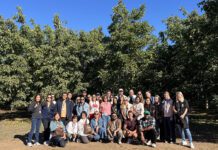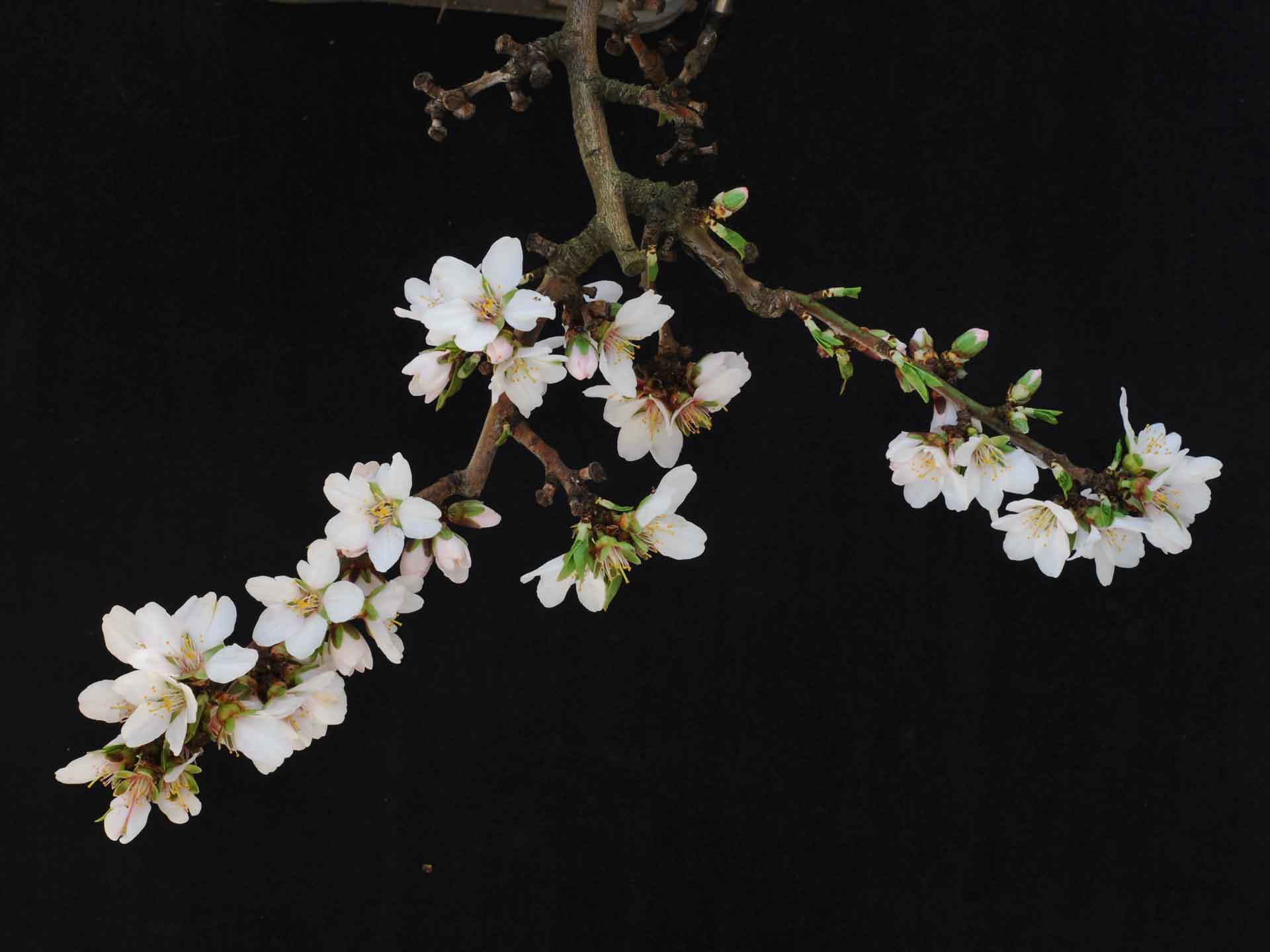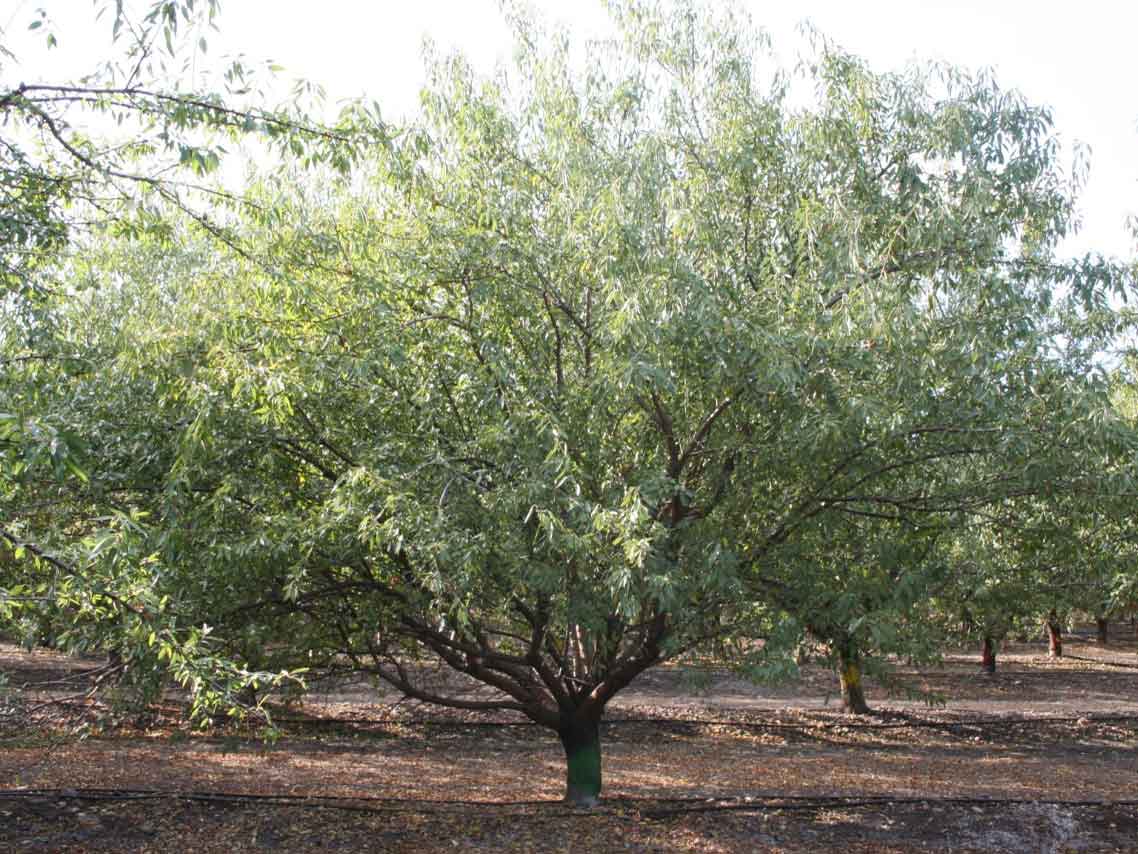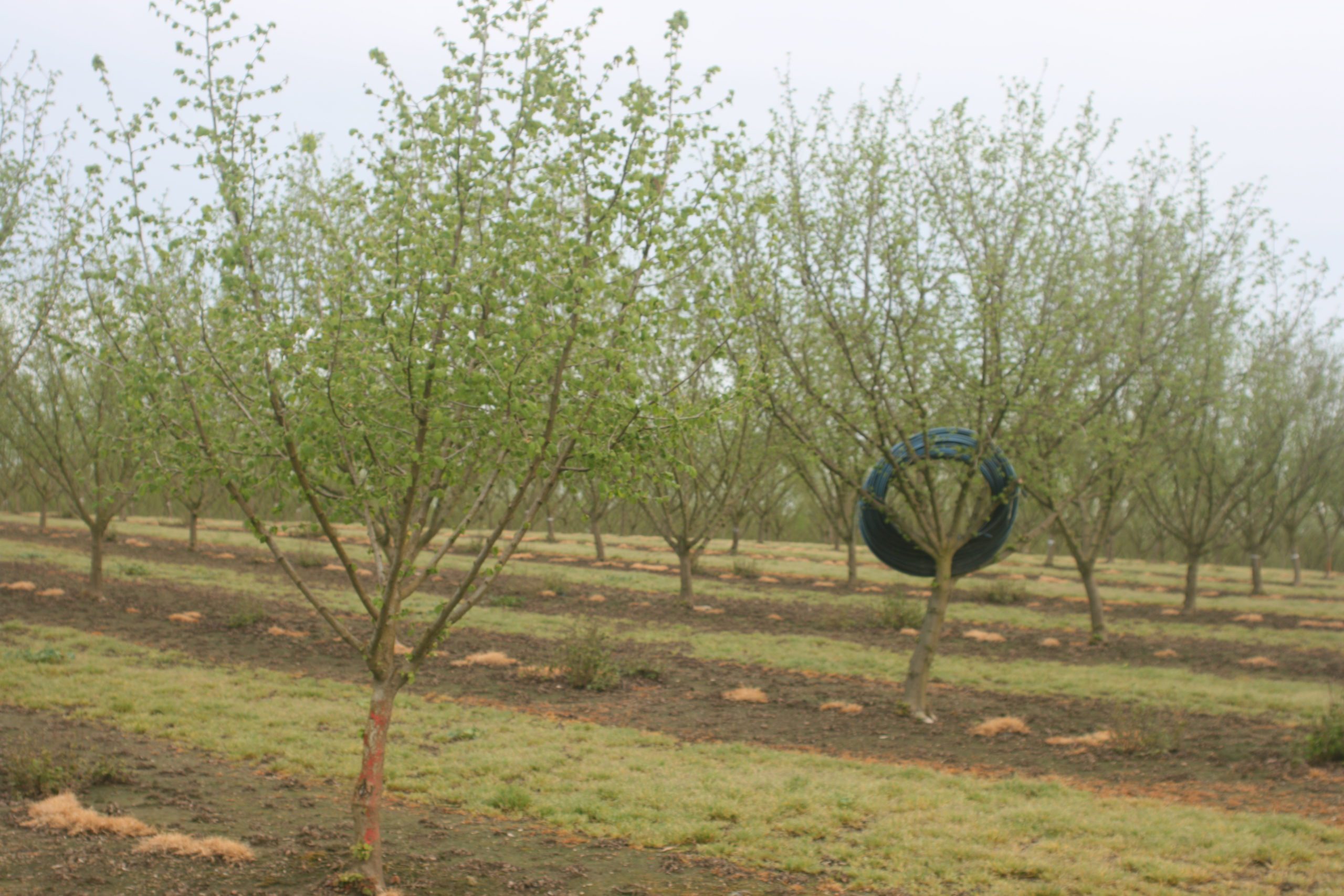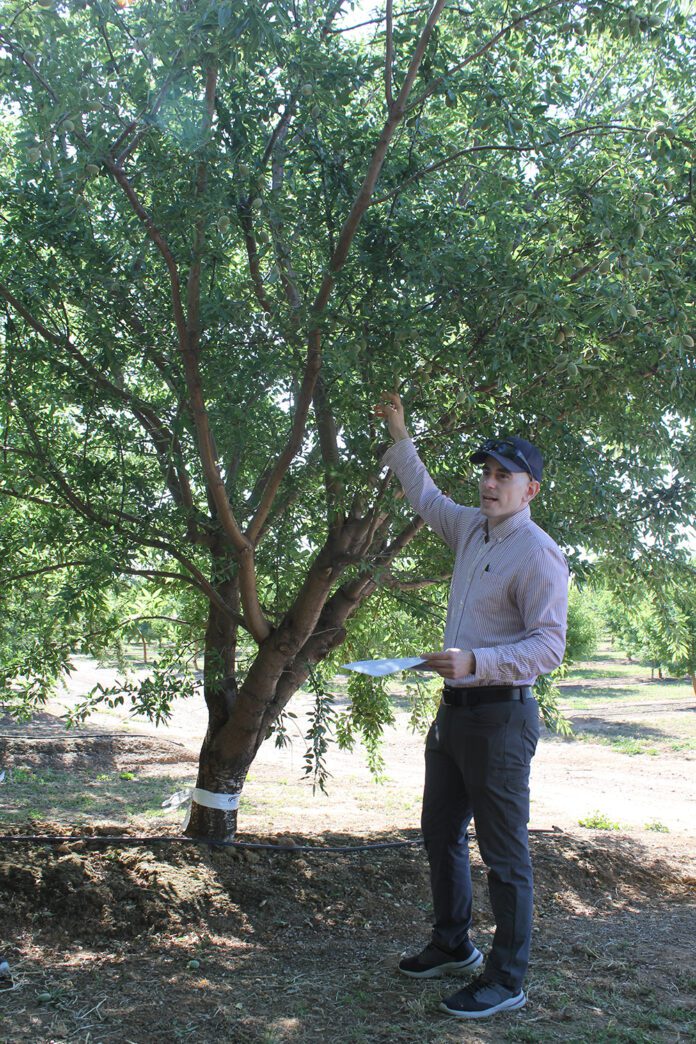
Listen to the audio version of this article. (Generated by A.I.)
The 47th annual Nickels Soil Lab field day, true to its deep roots in the almond industry, provided a range of tools and production advice for the crowd of growers in attendance. Below is an update on some of the latest findings to come out of Nickels.
Nickels is the largest almond research facility in the U.S., with more than 100 acres of almond varieties, both traditional and experimental. Walnuts and olives are also grown at Nickels for research purposes. Projects at Nickels are responsible for the expansion of drip irrigation in almonds and supported cost-saving pruning practices in almonds and walnuts.
Speaker Luke Milliron, orchard systems farm advisor in Butte, Glenn and Tehama counties, said planting a new almond variety comes down to how much risk a grower is willing to take. In his update on Sacramento Valley almond variety trials, he noted that while there have been successes, growers in his counties have been burned with bud failure issues, rootstock incompatibility and leaf-out failure in new varieties.
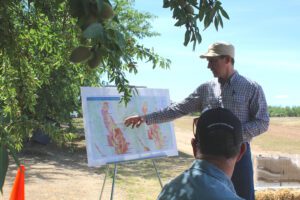
Genetic issues can play a part, but he has found some varieties are not resilient to environmental conditions where planted. While it can take “20 years to prove a variety,” Milliron said much has been learned in trials in the past 11 years.
Looking at the cumulatively top five yielding varieties at the Butte trial site, and despite efforts to develop superior varieties of almonds, the Nonpareil variety still is tops in yield and kernel quality. The trial also showed UCD 18-20 and Booth are high-yielding self-fertile varieties, but both produce high percentages of doubles.
Rootstock trials at Nickels are also proving their effect on tree vigor as well as economic incompatibility. Franz Niederholzer, UCCE orchards advisor in Colusa, Yuba and Sutter counties, said soil condition challenges and beneficial plant qualities influencing rootstock selection include tolerance to toxic elements, tolerance to physical challenges including wind and flooding, disease tolerance, nematode resistance and tolerance of high soil pH. Helpful or economically valuable traits include absence of suckering, early vigor, large kernels and compatibility with cultivars.
In recent Nickels experiences with rootstocks, shown in the Almond Board of California Almond Rootstocks publication, Krymsk rootstock is incompatible with Independence due to low vigor. Niederholzer said the most suitable rootstock will reduce the need for corrective action, improve profitability and extend the economic life of the orchard.
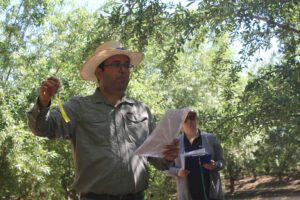
Whole Orchard Recycling
Effect on orchard water use with whole orchard recycling was demonstrated by UCCE Farm Advisor Cameron Zuber.
Orchards planted after whole orchard recycling (WOR) hold more water due to changes in the physical structure of the soil, Zuber said. As the wood chips decompose, the soil is able to hold more water in the root zone. Planting trees before decomposition has commenced can present a problem, as the large chips allow water to move faster. There is a benefit, he said, to waiting one to two years before planting after WOR.
Other considerations to planting after WOR include spreading the wood chips evenly across the orchard site and mixing the chips into the soil at least one to two feet below.
UCCE advisor Brent Holtz added tree nutrition recommendations for planting after WOR. Holtz has 20-plus years of data on whole orchard recycling, the practice of grinding trees into chips and spreading them back on the orchard site, then incorporating the chips into the soil. This practice adds high levels of carbon to the soil, which affects the carbon-to-nitrogen ratio. Holtz has conducted a series of trials to optimize the nitrogen rate.
“Growers don’t usually fertilize at planting, but with WOR, it is necessary,” Holtz said. He also recommends letting the orchard site sit for a year after WOR. With 20 years of data on WOR, Holtz said nitrogen applications in frequent, small doses achieved the most successful results. 0.25 oz nitrogen at planting promotes tree growth.
Waiting two years to plant trees gives the wood chips time to begin decomposition.
“It is a long process from wood to soil organic matter,” Holtz said. “It is a long-term investment.”
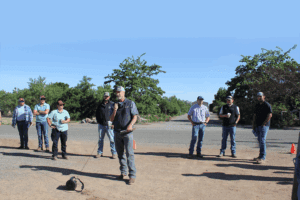
Pest Management and Phosphorus
Moving on to pest control, UCCE advisor Sudan Gyawaly, an IPM advisor in Sacramento County, emphasized the importance of monitoring for spider mite predators in almond orchards.
“All orchards have predators that could control spider mites if we use IPM practices and monitor,” Gyawaly said. The most common predators of spider mites are the western predator mite, sixspotted thrips, spider mite destroyer, ladybugs and lacewings.
Integrated pest management advises only applying insecticides if needed to control pests. To know when to spray or not requires monitoring for predator levels. Leaf sampling can provide information about the presence of both pests and predators.
If predators are present, Gyawaly advised not spraying if spider mites are present on less than about 35% of leaves. Spray is warranted if mites are present on more than 50% of leaves.
Monitoring can also be done with yellow sticky traps hung in trees. Treatment is unnecessary, he said, if finding an average of one thrips per card in April or May and infestation is less than 40%. In June and July, three thrips per card per week is the breakeven point. At five to six thrips per card per week, treatment is not advised.
Fall phosphorus fertilization and effect on nut set was discussed by UC plant science visiting scholar Or Sperling. Soil, water and rootstocks are the routes trees access this macronutrient. Phosphorus deficiency in almond production is not common, and Sperling said if trees are in maximum production and look healthy, phosphorus is not a problem.
Leaf analysis is not the route to take in diagnosing a deficiency. He said a soil test provides a better analysis, and if results are less than 10 ppm, phosphorus might be a limiting factor in production. Sperling noted that his research shows application rate depends on the level of the nutrient in the soil. Timing in late summer and fall is optimum.
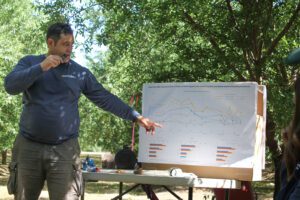
Barn Owl Habitat and Groundwater Recharge
Providing nest boxes for avian predators can help with control of rodents in orchards. Breanna Martinico, UC ANR human-wildlife interaction advisor, said cavity-nesting birds can be attracted to orchards with specially designed and properly maintained nest box networks.
Barn owls are the predominant avian predator species, as their diets are primarily gophers, voles, rats and mice. Martinico presented evidence of their presence at Nickels, as bones and teeth of gophers and voles were found under an orchard nest box.
She said most of the natural nesting sites for cavity-nesting barn owls and other species are absent from orchard sites. Using nest boxes will attract the birds, and they will continue to use them for several years, building populations.
“They won’t eliminate rodents. They are an IPM tool,” Martinico said.
Proper design and maintenance of the nest boxes will ensure their return on investment. Since barn owls, the most likely occupants, are not territorial, they can be placed closer together on property. Shade from summer heat means orienting the opening toward the east. Martinico said signs the boxes are being used include a rodent graveyard on the ground under the boxes.
Groundwater recharge opportunities were the final presentation on the orchard tour. Supplied by Curt Pierce, UCCE area irrigation and water resources advisor, information included site suitability, planning and crop tolerance.
Groundwater recharge is a strategy to apply excess surface water onto fields, orchards or basins to help replenish groundwater aquifers. Pierce noted that groundwater recharge can help restore balance and availability required by the Sustainable Groundwater Management Act.
In almonds, recharge is a viable practice during dormancy. There is a risk of nutrient leaching when recharge is attempted during the growing season. Resources for implementation of groundwater recharge in almond orchards can be found at the Almond Board of California website.

Cecilia Parsons
Cecilia Parsons has lived in the Central Valley community of Ducor since 1976, covering agriculture for numerous agricultural publications over the years. She has found and nurtured many wonderful and helpful contacts in the ag community, including the UCCE advisors, allowing for news coverage that focuses on the basics of food production.
She is always on the search for new ag topics that can help growers and processors in the San Joaquin Valley improve their bottom line.
In her free time, Cecilia rides her horse, Holly in ranch versatility shows and raises registered Shetland sheep which she exhibits at county and state fairs during the summer.






